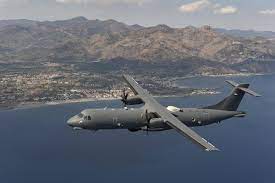Italy sets out future MPA capability requirements and timeframes

Rome: Italy’s MPA capability is generated jointly by the Italian Air Force (ITAF) and Italian Navy (ITN). Discussing how to meet Italy’s future maritime surveillance and engagement capability requirements with a long-range multi-mission MPA, Brigadier General Francesco Agresti – an ITAF officer posted to the ITN’s Office of the Marine Aviation Inspector (ISPAVIAMAR) – told SAE Media Group’s Maritime Reconnaissance and Surveillance Technology conference in London in late January that a long-range, wide-area ASW capability is something “we urgently need to retrieve”.
Italy’s current multi-mission MPA – the Leonardo P-72A – does not carry an ASW capability, instead focusing broadly on maritime surveillance. Entering service in 2016 and 2017, four P-72As were purchased to provide a ten-year interim capability to bridge the gap from Italy’s P1150 Dassault-Breguet Atlantic aircraft to a future MPA.
“We are pretty satisfied with P-72A. Indeed, we are trying to get out of it the maximum operational profit,” said Brig Gen Agresti. However, he explained, the deteriorating Euro-Atlantic security situation means some aspects of the capability gap can no longer be endured.
“We are looking forward to acquiring a more capable platform. We think that – besides intelligence, surveillance, and reconnaissance – ASW capability is really necessary.”
Brig Gen Agresti underscored the need to close the gap quickly, stating that Italy is aiming to acquire a new MPA by 2029. He added that the procurement process is progressing.
While Italy has been working through the future MPA capability requirements process, including finding the right balance between ITAF and ITN needs, what has become time-urgent is the need to re-establish an MPA-based ASW capability to provide coverage across the Mediterranean, Brig Gen Agresti explained.
“We are witnessing a growing interest from several non-NATO Mediterranean countries, but also growing appetites from other world powers like Russia and sometimes China that are sending clear signs of their ambitions to strengthen their presence,” said Brig Gen Agresti. “We are witnessing in recent decades a meaningful proliferation of non-NATO submarines.”
“The ASW threat has been recognised as one of the main NATO shortfalls,” he continued, adding that the ASW shortfall is acute in the Mediterranean.
Brig Gen Agresti noted that the Mediterranean Sea’s blue-water and littoral regions remain areas of global political significance, with the region’s key choke points, sea lines of communication, at-sea natural resources, and critical undersea infrastructure nodes – not to mention the prevailing instability on the Mediterranean’s eastern and southern flanks – underscoring this significance.
“A distinguishing trait of the Mediterranean is also that it is a confined maritime environment … therefore likely to be congested and, in case of crisis, contested and constrained,” Brig Gen Agresti continued.
Thus, a long-range, multi-mission MPA able to generate enduring, wide-area surveillance and situational awareness will be critical to building a common, recognised maritime operating picture. “In such a complex geostrategic framework, a good awareness of maritime activity is surely a vital precondition for the protection of both national and international interests,” said Brig Gen Agresti.
As regards Future MPA requirements, Italy has noted developments across NATO that have focused on building collaborative programmes and on delivering more capable MPAs.
Brig Gen Agresti spelled out Italy’s ASW, and broader maritime surveillance, capability requirements for its future MPA. These include: ASW and anti-surface warfare (ASuW), encompassing advanced engagement capabilities; multispectral intelligence, surveillance, target acquisition and reconnaissance; robust and secure long-range communications, enhanced with ‘net-capable’ connectivity; high survivability in non-permissive environments, including capability to counter contemporary electronic and kinetic threats; high operational reach, including through speed, range, payload, endurance, and time on station; day/night and all-weather capabilities; and deployability with minimal logistics support.
Various MPAs are available on the market. In his presentation, Brig Gen Agresti listed three that he said are currently more likely to be considered. In alphabetical order, these are: Boeing’s P-8A Poseidon; the Kawasaki P-1; and Leonardo’s C27J ASW.





